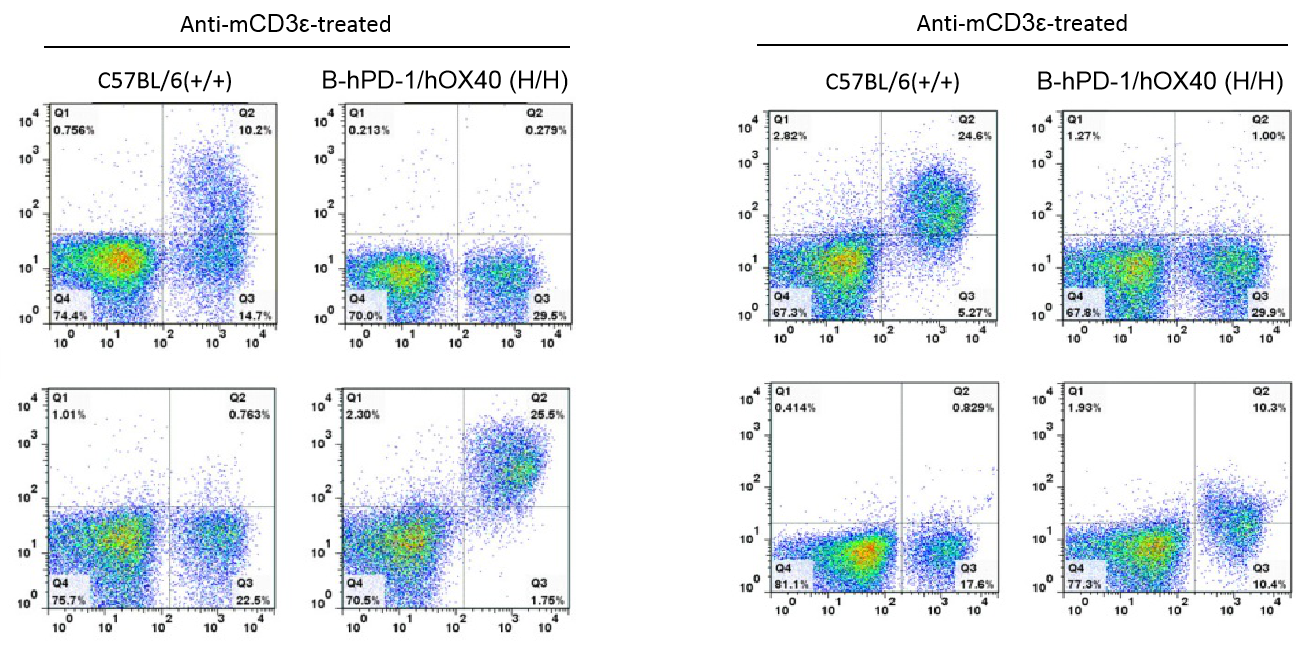中文
B-hPD-1/hOX40 mice
模型验证
Protein expression analysis

Strain specific OX40 and PD-1 expression analysis in homozygous B-hPD-1/hOX40 mice by flow cytometry. Splenocytes were collected from WT and homozygous B-hPD-1/hOX40 (H/H) mice stimulated with anti-CD3ε in vivo (7.5 μg/mice), and analyzed by flow cytometry with species-specific anti-OX40 antibody. Mouse OX40 and PD-1 were exclusively detected in WT mice. Human OX40 and PD-1 were exclusively detected in homozygous B-hPD-1/hOX40 but not WT mice.
Combination therapy of PD-1(pembrolizumab) Ab and OX40 Ab

Antitumor activity of anti-hOX40 antibody combined with anti-hPD-1 antibody pembrolizumab in B-hPD-1/hOX40 mice. (A) Anti-hOX40 antibody combined with anti-hPD-1 antibody pembrolizumab inhibited MC38 tumor growth in B-hPD-1/hOX40 mice. Murine colon cancer MC38 cells (5×105) were subcutaneously implanted into homozygous B-hPD-1/hOX40 mice (female, 6-7 week-old, n=6). Mice were grouped when tumor volume reached approximately 150±50 mm3, at which time they were treated with anti-hOX40 antibody combined with anti-hPD-1 antibody pembrolizumab with doses and schedules indicated in panel (B) Body weight changes during treatment. As shown in panel A, combination of anti-hOX40 and anti-hPD-1 antibody shows more inhibitory effects than individual groups, demonstrating that the B-hPD-1/hOX40 mice provide a powerful preclinical model for in vivo evaluating combination therapy efficacy of hOX40 antibodies and hPD-1 antibodies . Values are expressed as mean ± SEM.

Antitumor activity of anti-hOX40 antibody combined with anti-hPD-1 antibody pembrolizumab in B-hPD-1/hOX40 mice. (A) Anti-hOX40 antibody combined with anti-hPD-1 antibody pembrolizumab inhibited B16-F10-hPD-L1 cells tumor growth in B-hPD-1/hOX40 mice. Murine colon cancer B16-F10-hPD-L1 cells (1×105) were subcutaneously implanted into homozygous B-hPD-1/hOX40 mice (female, 7-8 week-old, n=5). Mice were grouped when tumor volume reached approximately 150±50 mm3, at which time they were treated with anti-hOX40 antibody combined with anti-hPD-1 antibody pembrolizumab with doses and schedules indicated in panel (B) Body weight changes during treatment. As shown in panel A, combination of anti-hOX40 and anti-hPD-1 antibody shows more inhibitory effects than individual groups, demonstrating that the B-hPD-1/hOX40 mice provide a powerful preclinical model for in vivo evaluating combination therapy efficacy of hOX40 antibodies and hPD-1 antibodies . Values are expressed as mean ± SEM.
Copyright © 2024 百奥赛图江苏基因生物技术有限公司. All Rights Reserved
备案号: 苏ICP备2021053911号-1
 苏公网安备:32068402320845号
网站建设:北京分形科技
苏公网安备:32068402320845号
网站建设:北京分形科技
 苏公网安备:32068402320845号
网站建设:北京分形科技
苏公网安备:32068402320845号
网站建设:北京分形科技






 010-56967680
010-56967680 info@bbctg.com.cn
info@bbctg.com.cn